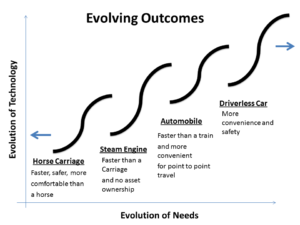Every disruption of an industry looks perfectly logical in hindsight. We snicker at the unpreparedness of the poor souls who got disrupted. Did the horse-carriage folks really think they could stop the steam engine? (people needed faster transportation, not a faster horse carriage). Did the steam engine industry really think they would not be affected by the personal automobile? (more people needed point-to-point transportation, not mass transit). And is the auto industry really ready for the driverless car? (people need transport, not a car).
Beyond the inevitability of disruption, you probably noticed in the example above that the same industry (transportation) was disrupted again and again. Each disruption was driven by an evolution of technology that actually redefined the NEED as well as the OUTCOME.
Wait! So what do cows and milk have to do with digital strategy?
It’s all about the outcome. The evolution of technology and needs feed upon each other, to keep evolving the outcome (see picture). The real answer to the cow o r milk question would probably be “it depends”. It depends on the core “need” (nutrition, taste etc) and the “technology” driven alternatives available. In the future world of Soylent, (which is a food alternative that “provides all the protein, carbohydrates, lipids, and micronutrients that a body needs to thrive”) perhaps the answer to the cow or milk question will be “neither”. Outcomes (e.g. nutrition) matter more than Products or Services or Processes (e.g. Cow or Milk or Milk bottle delivery).
r milk question would probably be “it depends”. It depends on the core “need” (nutrition, taste etc) and the “technology” driven alternatives available. In the future world of Soylent, (which is a food alternative that “provides all the protein, carbohydrates, lipids, and micronutrients that a body needs to thrive”) perhaps the answer to the cow or milk question will be “neither”. Outcomes (e.g. nutrition) matter more than Products or Services or Processes (e.g. Cow or Milk or Milk bottle delivery).
The key message here for your Digital Strategy is that as you digitize your enterprise, the evolution of technology and needs affords a unique opportunity to design for outcomes versus just historical work-processes.
Applying this to Processes and Business Functions in your enterprise…..
The idea of focusing on outcomes vs. products or services or processes applies at multiple levels. In this blog, I will focus on applying it to internal Shared Services in the enterprise. Outcome-based work processes can multiply the impact of Exponential Technologies (e.g. Artificial Intelligence, Machine Learning, Cloud, Robotics and so on). Here’s a few examples specifically aimed at processes in the Supplier, Customer, Customer Support management, and Travel systems that are typically in Shared Services Organizations (SSOs).
Call Center support operations – Let’s face it – if the Call Center is about fixing issues, then each contact is a productivity hit for both the employee and the Call Center. The outcome that matters is the proactive elimination or avoidance of the issues. Where that’s not fully possible, the contacts can provide extreme delight in the delivery of services (the famous story of Zappos, an online shoe company, even taking calls related to ordering pizza might be an outlier, but it doesn’t need to appear far-fetched).
Transactional billing, reporting and customer operations – With Robotics Process Automation, Machine Learning, open ecosystems of data and AI, the question is how much of these transactions are value accretive to the enterprise vs. being just “cost of operations”. Again, can we minimize or even eliminate transactions?
Travel services – Unless your Travel policies actually provide a better personalized experience at a lower cost than what you get in the open travel market, you have opportunities. The outcome that matters is the most effective travel meeting outcome and safe experience for your employees. It is very unlikely that you will beat the open market consistently at this, unless your goal is to maintain travel as a high value employee experience or as a perk. Look at open booking policies, automated one-touch or no-touch expense reporting, Machine Learning for audit, gamification for cost management etc.
Supplier management systems – Are your supplier processes and systems intended to help your suppliers to cope with the complexities of doing business with, or simply self-serve themselves? Ideally, it is the latter.
Customer management systems – While the high value human tasks of customer relationship building will always be done via your Sales and Marketing organization (i.e. humans), the transactional tasks supporting them can be done via algorithms. The opportunity here is more than automating the processes using software robots. You can redesign the tasks of sales and marketing into significantly higher order human relationship work.
We could go on, but you get the idea….
The effect of Outcome-based digitization on Business Functions
There’s one final effect of Outcome-based processes and it is a big one. Digitizing for outcomes will change the profile of talent in just about all functions. The functional roles become less about using the technology for productivity and more about training the technology to run the business under your supervision. That blurs the lines between the relevant function and the IT function. The good news though is that it frees up capacity for more personalized relationship building from Marketing; More win-win business building from Sales; More breakthrough innovation from R&D and so on.
Where to start?
Don’t just digitize your enterprise; use the opportunity to design for outcomes. You need to create new business models internal and external to the company. Your digital strategy needs to be deliberate in designing for transportation, not for just a new car.
What do you think? Agree? Disagree?

